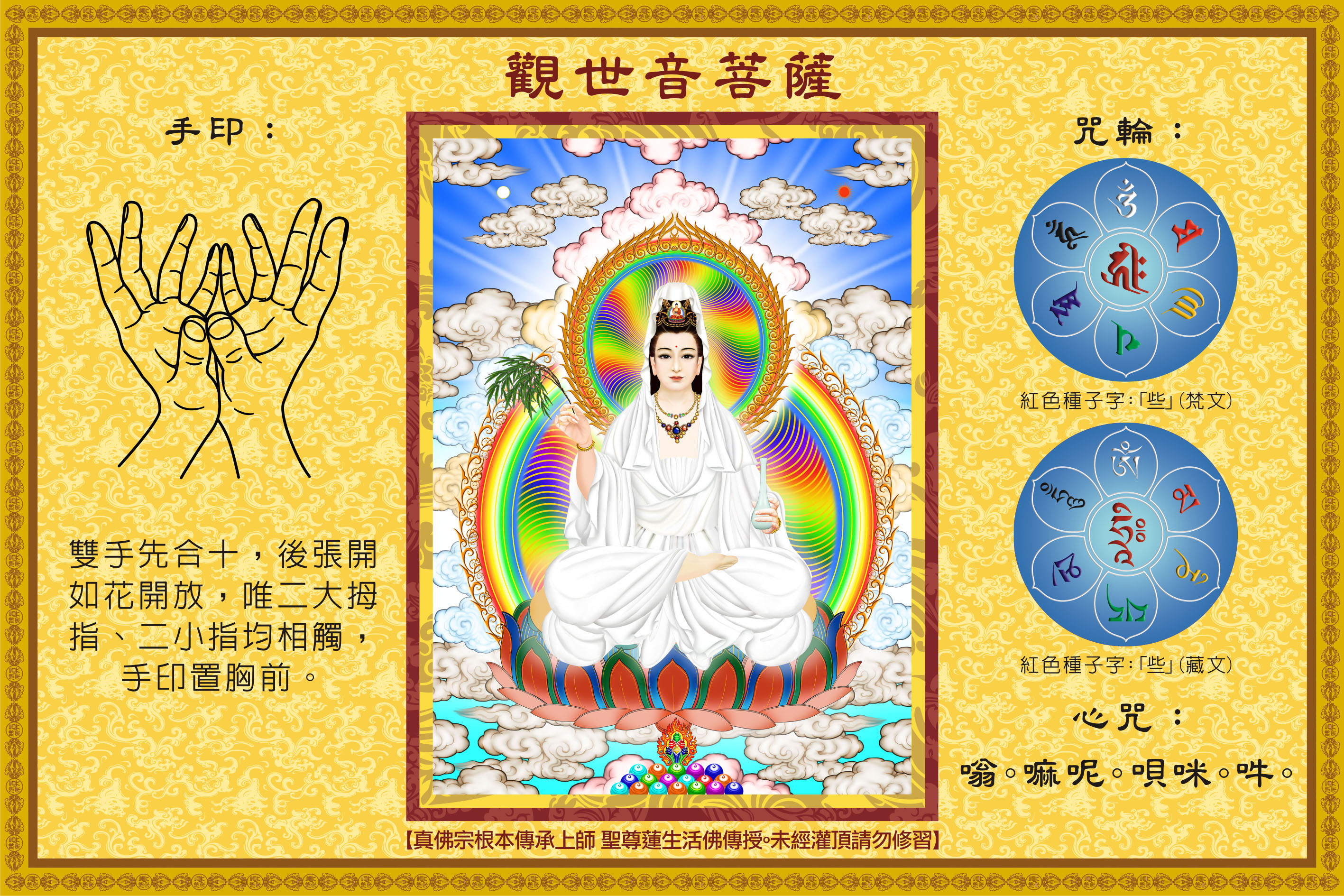首頁 (home) | 佛緣 (fate) | 隨喜 (rejoice) | 功德 (donation)
觀世音菩薩 अवलोकितेश्वर Avalokiteśvara 観音菩薩

中文:
觀世音菩薩(梵語:अवलोकितेश्वर,Avalokiteśvara;或梵語:अवलोकितस्वर,Avalokitasvara),漢語音譯為「阿婆盧吉低舍婆羅」、「阿縛盧枳低濕伐邏」,名號意為「觀察世間音聲覺悟有情」或者「觀察自在」,又譯為觀音菩薩、觀自在菩薩,手持蓮花的觀音菩薩也被稱爲蓮花手菩薩或持蓮觀音(Padmapani)。漢地佛教自唐代開始主要是以蓮華部母白衣觀音為所有觀世音菩薩的本尊;在民間信仰中常被尊稱觀音佛祖、觀音大士、觀音娘娘、觀音媽、白衣大士。在密教中,祂為蓮華部尊,在淨土宗則是西方淨土的大菩薩,與大勢至菩薩分別為阿彌陀佛的左、右脅侍菩薩,並稱「西方三聖」,與地藏王菩薩分別為釋迦牟尼佛的左、右脅侍菩薩,並稱「娑婆三聖」,同時祂也是四大菩薩之一。
在早期的佛經中,多譯自梵語「Avalokitasvara」,為「闚音」、「現音聲」,竺法護和尚譯為「光世音菩薩」,南北朝姚秦時的鳩摩羅什法師譯為「觀世音菩薩」。
唐代玄奘法師等譯師們則譯自梵語「Avalokiteśvara」為「觀自在菩薩」。「Avalokita」為「觀」,「iśvara」為「自在」,意為觀照自身本性皆空而得自在者,故玄奘譯為觀自在菩薩,可見於今日的《般若心經》。
傳統上以為,因唐太宗李世民的本名當中有個「世」字,為了避諱,故當時將「觀世音菩薩」改稱為「觀音菩薩」,但也有說法認為「觀音菩薩」只是「觀世音菩薩」的簡稱。唐代清涼澄觀法師指出在梵文古本中存在兩種不同的名稱,1927年新疆出土的古抄本中,以 अवलोकितस्वर(Avalokitasvara)為觀音菩薩的名稱,證實了他的說法。「娑伐羅」(स्वर svara),意思為「聲音」,Avalokitasvara 可意譯為「觀音」,鳩摩羅什出生在西域地區,所見的應該就是這個版本。因此,觀音菩薩並非是因為避諱而出現的名稱。根據唐代玄應的說法,這可能是來自於不同地區方言所導致的。
「觀世音菩薩」從字面解釋就是「觀察世間聲音」的菩薩,出自《妙法蓮華經》之《觀世音菩薩普門品》:「若有無量百千萬億眾生,受諸苦惱,聞是觀世音菩薩,一心稱名,觀世音菩薩即時觀其音聲,皆得解脫。」又說:「若有眾生,多於淫慾,常念恭敬觀世音菩薩,便得離欲。若多瞋恚,常念恭敬觀世音菩薩,便得離瞋。若多愚癡,常念恭敬觀世音菩薩,便得離癡。」
觀世音菩薩在藏文作སྤྱན་རས་གཟིགས་དབང་ཕྱུག(藏語拼音:Jänräsigwangchug),也是「觀自在」之意,與玄奘法師等譯師們譯意相同。因為藏文「觀自在」總共有五個藏語的音節,所以藏文書面、口語通常略稱「Jairaisig(「觀」、「眼視」)」三個音節,而省略了「wangjug(「自在」)」兩個音節。
大中華地區佛教與道教乃至民間信仰所稱的白衣觀音、白衣大士、觀音媽則取自唐朝密宗信仰的Pāndara vāsinī,為女性觀音菩薩,她是觀音母乃為蓮華部母與蓮華部主,在不同的經典有不同的譯名,在不空所翻譯的《菩提場所說一字頂輪王經》譯名為白衣觀自在,以及《攝無礙大悲心大陀羅尼經計一法中出無量義南方滿願補陀落海會五部諸尊等弘誓力方位及威儀形色執持三摩耶幖幟曼荼羅儀軌》譯名為白衣觀世音菩薩、白身觀音,在善無畏所翻譯的《蘇悉地羯羅經》譯名為觀音母,還有善無畏講述一行筆記的《大毘盧遮那成佛經疏》譯名為白處尊、觀音母以及稱她為蓮花部主。
到了宋代密宗經典,如施護所翻譯的《佛說一切如來金剛三業最上祕密大教王經》與《一切祕密最上名義大教王儀軌》則譯名為白衣菩薩,菩薩就是大士這也是民間稱她為白衣大士之名的由來。
English:
Guanyin (traditional Chinese: 觀音; simplified Chinese: 观音; pinyin: Guānyīn) is a Bodhisattva associated with compassion. She is the East Asian representation of Avalokiteśvara (Sanskrit: अवलोकितेश्वर) and has been adopted by other Eastern religions, including Chinese folk religion. She was first given the appellation "Goddess of Mercy" or "Mercy Goddess" by Jesuit missionaries in China. Guanyin is short for Guanshiyin, which means "Perceives the Sounds of the World." On the 19th day of the sixth lunar month, Guanyin's attainment of Buddhahood is celebrated.
Some Buddhists believe that when one of their adherents departs from this world, they are placed by Guanyin in the heart of a lotus, and then sent to the western pure land of Sukhāvatī. Guanyin is often referred to as the "most widely beloved Buddhist Divinity" with miraculous powers to assist all those who pray to her, as is mentioned in the Pumen chapter of Lotus Sutra and Kāraṇḍavyūha Sūtra.
Several large temples in East Asia are dedicated to Guanyin, including Shaolin Monastery, Longxing Temple, Puning Temple, Nanhai Guanyin Temple, Dharma Drum Mountain, Kwan Im Thong Hood Cho Temple, Shitennō-ji, Sensō-ji, Kiyomizu-dera, Sanjūsangen-dō, and many others. Guanyin's abode and bodhimaṇḍa in India is recorded as being on Mount Potalaka. With the localization of the belief in Guanyin, each area adopted their own Potalaka. In Chinese Buddhism, Mount Putuo is considered the bodhimaṇḍa of Guanyin. Naksansa is considered to be the Potalaka of Guanyin in Korea. Japan's Potalaka is located at Fudarakusan-ji. Tibet's Potalaka is the Potala Palace. Vietnam's Potalaka is the Hương Temple.
There are several pilgrimage centers for Guanyin in East Asia. Putuoshan is the main pilgrimage site in China. There is a 33 temple Guanyin pilgrimage in Korea which includes Naksansa. In Japan, there are several pilgrimages associated with Guanyin. The oldest one of them is the Saigoku Kannon Pilgrimage, a pilgrimage through 33 temples with Guanyin shrines. Guanyin is beloved by most Buddhist traditions in a nondenominational way and found in most Tibetan temples under the name Chenrézik (Wylie: Spyan ras gzigs). Guanyin is also beloved and worshipped in the temples in Nepal. The Hiranya Varna Mahavihar located in Patan is one example. Guanyin is also found in some influential Theravada temples such as Gangaramaya Temple, Kelaniya and Natha Devale nearby Temple of the Tooth in Sri Lanka; Guanyin can also be found in Thailand's Temple of the Emerald Buddha, Wat Huay Pla Kang (where the huge statue of her is often mistakenly called the "Big Buddha") and Burma's Shwedagon Pagoda. Statues of Guanyin are a widely depicted subject of Asian art and found in the Asian art sections of most museums in the world.
日本語:
観音菩薩(かんのん ぼさつ、梵: Avalokiteśvara)は、仏教の菩薩の一尊。観世音菩薩(かんぜおんぼさつ)、観自在菩薩(かんじざいぼさつ)、救世菩薩(くせぼさつ・ぐせぼさつ)など多数の別名がある。一般的に「観音さま」とも呼ばれる。
観音菩薩の起源や性別には定説がない。
友松圓諦は『般若心経講話』(1956年)の中で、「どこか、観自在菩薩の信仰のつよい地方、また、密教の呪文が珍重されていた地方」に起源を求めた。桐山靖雄も『般若心経瞑想法』(1994年)の中で、龍樹『大智度論』にある一節「観世音菩薩ら他方の仏土より来る」を援用して、この説を敷衍した。
岩本裕はインド土着の女神が仏教に取り入れられた可能性を示唆しており、エローラ石窟群、サールナートなどインドの仏教遺跡においても観音菩薩像と思しき仏像が発掘されている。
ゾロアスター教においてアフラ・マズダーの娘とされる女神アナーヒターやスプンタ・アールマティとの関連も指摘されている。
名称の由来
サンスクリットのアヴァローキテーシュヴァラ(Avalokiteśvara)を、玄奘は「観察された(avalokita )」と「自在者(īśvara)」の合成語と解釈し「観自在」と訳した。鳩摩羅什訳では「観世音」であったが、玄奘は「古く光世音、観世音、観世音自在などと漢訳しているのは、全てあやまりである」といっている。
一方で、中央アジアで発見された古いサンスクリットの『法華経』では、アヴァローキタスヴァラ(avalokitasvara)となっており、これに沿えば「観察された(avalokita)」+「音・声(svara)」と解され、また古訳では『光世音菩薩』の訳語もあることなどから、異なるテキストだった可能性は否定できない。なお、現在発見されている写本に記された名前としては、avalokitasvaraがもっとも古形であり、ローケーシュ・チャンドラはこの表記が原形であったとしている。
観音菩薩という呼び名は、唐の太宗皇帝の忌み名が世民であったため改称された。一般的には観世音菩薩の略号と解釈されている。
日本語の「カンノン」は「観音」の呉音読みであり、連声によって「オン」が「ノン」になったものである。
COPYRIGHT © Dukkha Buddhism | Donation since 2006